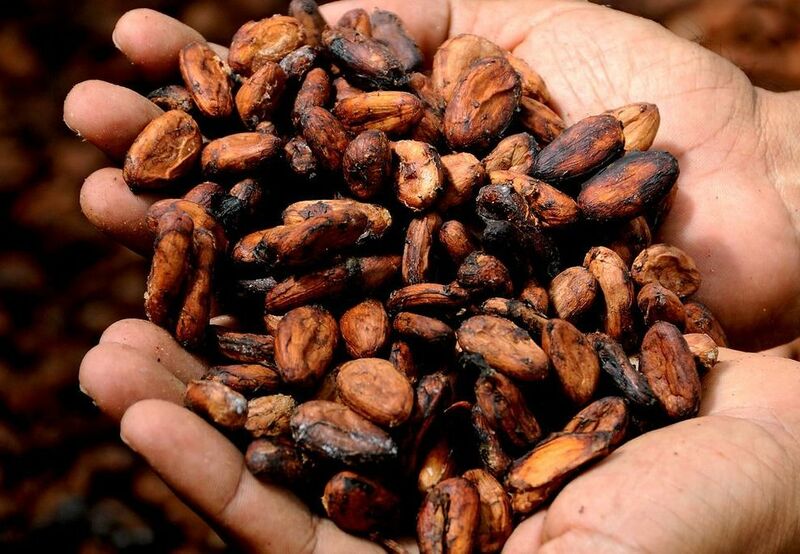
Dec ICE NY cocoa (CCZ23) on Friday closed +46 (+1.26%), and Dec ICE London cocoa #7 (CAZ23) closed +49 (+1.52%).
Cocoa prices Friday recovered from early losses and moved higher, with NY cocoa climbing to a 1-month high and London cocoa climbing to a new all-time high. Tight inventories are boosting cocoa prices as ICE-monitored cocoa inventories held in U.S. ports have declined steadily over the past four months to a 1-1/2 year low Friday.
Cocoa prices Friday shook off early weakness tied to weaker-than-expected cocoa demand. The National Confectioners Association reported Friday that Q3 North American cocoa grindings fell -18% y/y to 97,881 MT, weaker than expectations of a -12% y/y decline and the fewest grindings for a Q3 in 15 years. On Thursday, the Cocoa Association of Asia reported that Asia Q3 cocoa grindings fell -8.5% y/y to 211,468 MT. Other demand figures have been supportive of cocoa prices. Gepex, an exporter group that includes six of the world's biggest cocoa grinders, reported Tuesday that its Q3 cocoa processing was up +7% y/y to 183,731 MT. Last Thursday, the European Cocoa Association reported that European Q3 cocoa processing fell -0.9% y/y to 366,298 MT, an improvement from the -5.7% y/y decline in Q2.
Cocoa prices have trended higher over the past year, with nearest-futures (U23) NY cocoa climbing to a 44-year high on September 13 and London cocoa posting an all-time nearest-futures high Friday on concern about global cocoa production. Due to recent heavy rain in West Africa, black pod disease has spread. The spread of the disease, which causes cocoa pods to turn black and rot, could result in lower cocoa crop quality and production and push the global cocoa market into a third year of deficit for the 2023/24 season.
Also, the spread of the swollen shoot virus is threatening Ivory Coast cocoa crops. The virus is transmitted via mealybugs that feed on the sap of cocoa plants and will significantly reduce cocoa crop yields before eventually killing the plant. Tropical Research Services estimates that about 20% of the cocoa crop in the Ivory Coast is infected with the swollen shoot virus.
Concern about lower cocoa production in Ghana, the world's second-largest producer, is a positive development for cocoa prices. Ghana's cocoa regulator said on August 16 that its cocoa farmers would unlikely be able to fulfill some of its cocoa contracts for a second season. Ghana's regulator postponed 44,000 MT of cocoa shipments to future seasons due to a lack of supplies. Ghana's 2022/23 cocoa crop is now expected at around 650,000 MT, a 13-year low and 24% below initial estimates of 850,000 MT, as a lack of fertilizers and black pod disease hurt cocoa yields.
The Ivory Coast 2023/24 main cocoa harvest has begun favorably after Monday's Ivory Coast government data showed Ivory Coast farmers shipped 114,335 MT of cocoa to ports the week from October 1-15, up +7.7% from the same time last year. The Ivory Coast is the world's largest cocoa producer.
Cocoa prices remain well supported by concern that an El Nino weather event could undercut global cocoa production. On June 8, the U.S. Climate Prediction Center said that sea surface temperatures across the equatorial Pacific Ocean had risen 0.5 degrees Celsius above normal, and wind patterns have changed to the point where El Nino criteria have been met. Cocoa prices rallied to 12-year highs in 2016 after an El Nino weather event caused a drought that hampered global cocoa production.
Increased cocoa supplies from Nigeria, the world's fifth-largest cocoa bean producer, are bearish for prices after Nigeria's Aug cocoa exports rose +29.6% y/y to 14,025 MT.
The recent surge in cocoa prices is beginning to curb U.S. demand for chocolate. Data from Circana shows U.S. chocolate sales in the four weeks ended October 8 fell -9.2% y/y.
The International Cocoa Organization (ICCO) forecasts global 2022/23 cocoa production to increase +2.4% y/y to 4.938 MMT and global cocoa grindings to increase +0.2% y/y to 5.005 MMT. The ICCO estimates the total end of season 2022/23 global cocoa stocks of 1.707 MMT and the cocoa stocks-to-grinding ratio to fall to a 7-year low of 34.5%. The ICCO projected a global cocoa deficit for 2022/23 of -146,000 tons and said, "The expectation of a supply deficit has been compounded with weather variations, especially in West Africa."
On the date of publication, Rich Asplund did not have (either directly or indirectly) positions in any of the securities mentioned in this article. All information and data in this article is solely for informational purposes. For more information please view the Barchart Disclosure Policy here.






